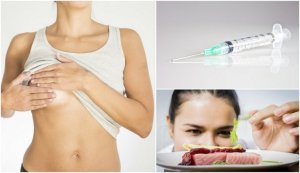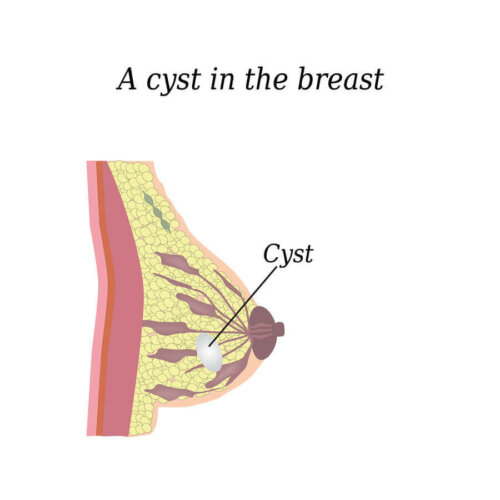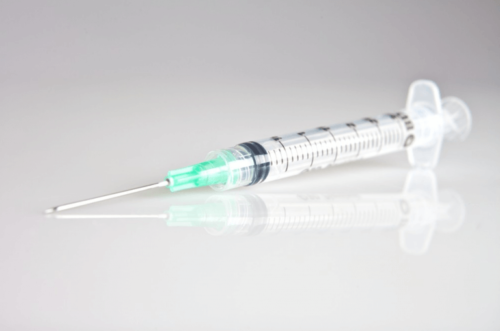Treatments for Controlling Breast Cysts


Reviewed and approved by the doctor José Gerardo Rosciano Paganelli
There are treatments for controlling breast cysts, small sacs of liquid that form in breast tissue. They can be alarming for a lot of women when they do a self-breast exam and feel them, but they’re actually benign and not often serious.
They appear in one or both breasts and generally feel like a grape or ball filled with water. Size and shape can vary. They’re very common in women between 30 and 60 but can appear at any age since they’re due to many reasons.
Today there are several ways of treating breast cysts that address their tendency to continue to grow, as well as the pain and inflammation.
We’d like to take this opportunity to share their main causes and treatment options. Don’t miss out!
What causes breast cysts?

Breast cysts are caused by benign changes in the mammary glands. Often, they’re the result of a blockage of the lobule outlets in the breasts, and this causes fluid accumulation.
According to some experts, “90 percent of nodules in young women are due to a benign condition. However, it’s necessary to obtain a proper diagnosis.”
Regarding the causes of breast cysts, it’s important to take into account the indications of the Mayo Clinic:
“Scientists don’t know the cause of breast cysts yet. These may manifest as a result of the hormonal changes of menstruation. Furthermore, there’s evidence indicating that excess estrogen in the body, which stimulates breast tissue, may contribute to the development of these cysts.”
This condition has a link to:
- Sudden hormonal changes, during or after menopause
- Overweight
- Excessive consumption of alcohol or smoking
- A poor diet
Check out these Seven Possible Causes of Your Breast Pain
Symptoms of breast cysts
Breast cysts may form in one or both breasts. The symptoms vary in each individual and depend on which stage it’s detected. The most common symptoms are:
- Round or oval bulges or balls, varied in shape, noticeable to the touch
- Pain in one or several areas of the breasts
- Sensitivity in the area of the lump
- Transparent or yellow secretion from the nipples
Breast tissue can often have a nodular consistency to the touch. In addition, it changes during the different phases of the menstrual period. Become familiar with it and monitor it so as to detect any changes.
Consult your doctor if you find a new nodule that doesn’t go away, becomes large, or remains after two or three menstrual cycles. You should also do so if you notice changes in the skin of your breasts.
The existence of these breast lumps or cysts doesn’t increase the risk of breast cancer in the future. Some that have a harder consistency may be more worrisome and their follow-up and treatment will depend on the results of the tests.
Treatment for controlling breast cysts
The good news is most cysts aren’t cancerous. Furthermore, some are so small doctors can only detect them with mammograms or mammary ultrasounds. While they’re not a big problem, your doctor will want to check them to make sure you won’t have any complications. If your doctor notices they’re growing, they may suggest:
1. Draining them with a needle

Furthermore, the doctor can intervene with a hypodermic needle aspiration procedure, as explained by the experts of the Western Breast Services Alliance, if they’re large enough to be palpated.
- It can be an uncomfortable treatment, but it isn’t painful and only lasts a couple of minutes
- Once done, the cysts are significantly smaller and may even seem to disappear
- You can repeat the procedure if the lumps reappear
Find out more about A Diet That May Help Prevent Breast Cysts
2. Hormone therapy
The doctor may suggest contraceptives or other hormonal treatments if the cysts are caused by certain hormonal imbalances in order to keep them from coming back.
- In this case, a doctor will evaluate the possible side effects and the patient’s state of health as it isn’t always the best choice
- In fact, this treatment is only recommended for women with fairly malignant breast cysts
3. Surgery to remove the breast cysts
Breast cyst removal surgery is only necessary for atypical situations or if the doctor sees any reason for concern. They’ll consider it if:
- The cyst causes daily discomfort
- And if they reappear every month after draining
- Also, if the fluid sac contains blood or looks worrisome
- Finally, if the tumor is cancerous
4. Natural remedies
Certain natural remedies can help with pain related to breast cysts. Also, making some dietary changes can help eliminate and prevent them.
Hot-cold compresses
The application of cold or hot compresses helps soothe sensitive breasts. They have an anti-inflammatory and analgesic effect that can give you relief from the pain within minutes.
Infusions
According to popular belief, the diuretic and anti-inflammatory properties of some natural infusions can help reduce the size of cysts.
Some of the recommended infusions are chamomile, plantain, peppermint, pennyroyal, and horsetail.
Diet

A healthy, balanced diet, rich in vitamin E and omega 3 fatty acids, can go a long way when you have breast cysts.
The consumption of ultra-processed food, salt (in large quantities), refined products, foodstuffs with high-fat content, or stimulants (caffeine) isn’t recommended.
Any doubts about controlling breast cysts? Consult your doctor
Do you feel a strange lump in your breasts? Don’t worry. Chances are that it’s nothing serious. However, consult your doctor and have a check-up to clear any doubts.
They’ll do a clinical examination that consists of palpating your breasts and lymph nodes. Depending on their findings and your history, they’ll decide if it is necessary to run some complementary tests. Many of them are routinary after a certain age and are of great help when it comes to diagnosing.
Among the most common studies are mammography, breast ultrasound, tumor markers performed through a blood test, and a breast biopsy. The latter consists of taking a sample of breast tissue to study it thoroughly under a microscope.
Finally, there are different treatments for controlling breast cysts and the one you need will depend on your particular case. Some of them have barely any side effects. Follow your doctor’s advice, get regular check-ups, and adopt healthy lifestyle habits to prevent the appearance of breast cysts.
All cited sources were thoroughly reviewed by our team to ensure their quality, reliability, currency, and validity. The bibliography of this article was considered reliable and of academic or scientific accuracy.
- Asociación Española Contra el Cáncer. Patología benigna del cáncer de mama.
- BARBERAN ZAMBRANO, G. J., & PALMA JARAMILLO, J. L. (2021). CÁNCER DE MAMA: PREVALENCIA, BIOMARCADORESTERAPIA BASADA EN NANOTECNOLOGÍA (Bachelor’s thesis, Jipijapa. UNESUM). Disponible en: http://repositorio.unesum.edu.ec/handle/53000/3143.
- Cirigliano M. D. Chamomile for use as anti-inflammatory, antispasmodic and sedative. Integrative Medicine. Septiembre 1999. 2: 100-104.
- Clínica Mayo. Quistes mamarios. Noviembre 2020.
- Kosir M. A. Quistes mamarios. Manual MSD. Septiembre 2020.
- Pulla, L. A. Á., Moreira, M. W. P., Silva, D. A. G., & García, E. D. M. (2021). Diagnóstico y tratamiento de los quistes mamarios. RECIMUNDO: Revista Científica de la Investigación y el Conocimiento, 5(3), 306-315. Disponible en: https://dialnet.unirioja.es/servlet/articulo?codigo=8056960.
- Vallejo, J. L. G., & Masats, M. M. (2020). Artículo Especial. Rol de la ecografía mamaria en la práctica ginecológica habitual. Disponible en: https://sego.es/documentos/progresos/v63-2020/n4/AE-ecografia-mamaria_V02.pdf.
- Western Breast Services Alliance. Quistes de seno. Department of Human Services through breast care. Noviembre 2003.
- Dixon JM, McDonald C, Elton RA, Miller WR. Risk of breast cancer in women with palpable breast cysts: a prospective study. Edinburgh Breast Group. Lancet. 1999 May 22;353(9166):1742-5. doi: 10.1016/s0140-6736(98)06408-3. PMID: 10347986.
- Boyle CA, Berkowitz GS, LiVolsi VA, Ort S, Merino MJ, White C, Kelsey JL. Caffeine consumption and fibrocystic breast disease: a case-control epidemiologic study. J Natl Cancer Inst. 1984 May;72(5):1015-9. PMID: 6585579.
- Mayo Clinic. Biopsia mamaria. (2021).
This text is provided for informational purposes only and does not replace consultation with a professional. If in doubt, consult your specialist.








